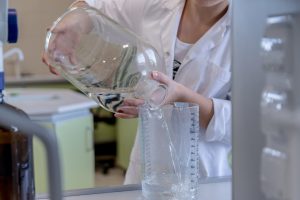Maintenance and Testing
As a well owner, you are responsible for assuring that it is safe. Routine inspection, testing, and preventative maintenance are recommended to ensure that you and your family have a safe and pure water supply today and for years to come.
Annual Checkups
Most well owners don’t contact someone about their water until there is a problem. However, even water that looks clean may not necessarily be safe. Annual checkups not only help you in keeping your water and equipment in good working condition they also establish a record of water quality that can be helpful in solving future problems.
Annual Checkup should include:
- Water System Inspection – Verify pump, pressure tank and controls performance. Confirm all equipment and supply systems meet local sanitary code requirements. Examine well head for possible methods of contaminant entry.
- Water Treatment Inspection- Verify that your treatment system is operating at maximum efficiency. All hydrochargers, filters, chemical injection pumps and other equipment are tested ensure proper operation. . Any preventative maintenance is performed, and any other required maintenance can be scheduled.
- Simple Water Test – review general water quality. Annual tests should include: Iron, Hardness, pH, Manganese, and TDS (Total Dissolved Solids). Incoming water test determines whether or not your water source is changing. Post treatment testing determines whether or not your water treatment is operating properly.
- Bacteria Test – to ensure the purity and safety of your water source. Bacteria tests are taken to the lab to be analyzed.
Water Testing
 There are various types of water tests offered. They start out very easy and inexpensive, but they can get very complicated and very pricey.
There are various types of water tests offered. They start out very easy and inexpensive, but they can get very complicated and very pricey.
Simple water tests – These are tests that can be performed by our staff. They are fairly inexpensive and the results are available immediately.
- Iron
- Hardness
- pH
- Manganese
- Chlorine
- TDS (Total Dissolved Solids)
Flow Test – A flow test is a test of your well’s yield. It reveals the pumping system’s maximum capacity and your well’s yield up to the maximum output of the pumping system. Ex. You can’t determine that a well makes 50 GPM (Gallons per Minute) if you only have a pumping system with a maximum capacity of 10 GPM. You can just determine that the well will make at least 10 GPM for a certain amount of time.
Lab Tests – These are tests that must be performed by a lab. They are varying in price and the results can take up to a week.
- Bacteria
- Sulfate
- Nitrates & Nitrites
- Oil and Grease
- VOC’s (Volatile Organic Compounds)
- Arsenic, Lead, and Copper
Other Times to Inspect
There are other situations that, when they occur, it is a good idea to have your equipment inspected and the water tested. Here are a few of the common situations when a well inspection should be conducted:
Medical Situations
- If you or your family have reoccurring incidents of gastro-intestinal illness – test for coliform bacteria, nitrate and sulfate.
- If you are planning to have a baby it is a good idea to test for nitrate in the first few months of the pregnancy, before you bring the baby home, and again during the baby’s first 6 months if you have a spring, hand dug well, or a shallow well.
 Environmental Situations
Environmental Situations
The quality of your water can be impacted by environmental and commercial changes that occur near your home. If your well is:
- near mining operations (coal, limestone, etc.) – Yearly flow tests, bacteria and all simple tests. It is critical that these tests be performed due to mining operation’s possible effects on the groundwater.
- near a gas or oil drilling operation – Test flow, bacteria, and all simple tests within 6 months before the drilling starts. This gives you a documented record of your water supply prior to their operation.
- near a gas station (operational/abandoned) or buried fuel storage tanks- test for VOC’s, and Oil and Grease as this could be result of leaking tanks.
- near a landfill, factory, dump, or junkyard – test for VOC’s, bacteria, nitrates & nitrites, and all simple tests. Contaminates could be soaking trough the ground and contaminating your water source.
- in an agricultural area – test for nitrates & nitrites and all simple tests. The products that farmers put on their fields and it’s runoff could be contaminating your water source.
- in an area that experienced flooding – test for bacteria. When surface water rises above the top of the well head it runs down the well and fills it with contaminated surface water. After the flood, chlorination is a must, followed by a series of bacteria tests.
Other Situations
- When purchasing water treatment- all simple tests. Some contaminates in water can drastically decrease the efficiency of filters and conditioners. The simple water tests determine the sizing and adjustments that must be made to water treatment equipment for it to function properly. Testing is a must prior to purchase and installation.
- When corrosion of fixtures and plumbing becomes a problem- test for pH. Variances from neutral can be corrosive and also stain.
- If you experience staining or residue in toilets, showers, etc- a simple water test can determine the source of your problem and your water treatment options can be explained to you.
